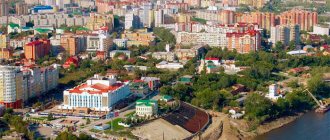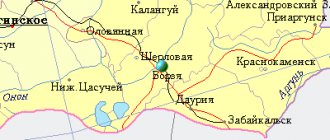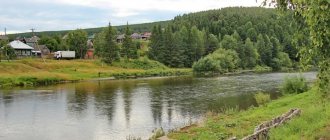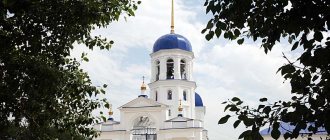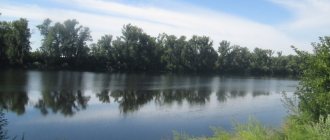Initially, Tobolsk was inhabited by Cossacks and settlers from central Russia and the Urals, which was located in close proximity to Siberia, endowed with untold riches. Russian pioneers, merchants, always striving inland, moved towards the Pacific Ocean, leaving behind settlements that later turned into cities. Tobolsk became the center of development of Siberia. It was founded by the Cossacks under the leadership of Ermak.
Foundation of the city
It is known that it was expensive for Russia to wage war against the Tatar khans on its eastern borders. Endless skirmishes with their detachments had a negative impact on the development of the territory of the Siberian Territory. Then the protection of the northeastern borders was entrusted to the Ural owner of the salt mines, the wealthy merchant Stroganov, and he entered into an agreement to protect the eastern borders with the Volga Cossacks led by Ermak. Thanks to the Cossacks, Siberia began to be explored by pioneers.
Tyumen became the first city of Siberia. The Tyumen fort was founded a year earlier than the Tobolsk one. Thanks to its advantageous position, it was Tobolsk that became the capital of Siberia for many years. The first population of Tobolsk were Russian settlers. Initially it was called the city of Siberia. The official date of its foundation is considered to be the summer of 1587, when the city of Tobolsk was founded 17 kilometers from the Tatar city of Isker on the banks of the Irtysh River, near the mouth of the Tobol.
This place was not chosen by chance. The construction of a settlement at the intersection of two large and navigable rivers was extremely profitable. After all, the only transport links in the taiga were rivers. Here, five years earlier, a battle took place between a Russian detachment of Cossacks and the army of the Tatar Khan Kuchum, a cunning and vile ruler who swore friendship to the Russian Tsar, and himself incited local tribes who traded with Orthodox merchants to attack Russian settlements and detachments.
Literature
- Slovtsov P. Walks around Tobolsk in 1830
, 1834 - A brief historical sketch of the city of Tobolsk
// Tobolsk Diocesan Gazette, 1887, No. 9-10, p. 168-177 - Znamensky M.S. Historical surroundings of the city of Tobolsk
, 1901 - Russia.
Complete geographical description of our Fatherland / Ed. V.P. Semenov-Tien-Shansky. T. 16. Western Siberia, St. Petersburg, 1907, p. 400-403. - Butsinsky P.N., Works in two volumes: T. 1. Settlement of Siberia and the life of its first inhabitants
/ Ed. S.G. Parkhimovich. Comp. Yu.L. Mandrika. - Tyumen, 1999, p. 107 - 143.
Development
The route from Russia to Siberia passed through the city. He developed quickly. Since 1590, it became a city and center for the development of Siberia. Peter I was very interested in it, who appreciated its importance and wanted to give it more representativeness. The population of Tobolsk also grew. Russian goods went through the city along the Yenisei and Tobol deep into Siberia, and in the reverse order furs and gold went to Russia. The city was getting rich. Construction was in full swing. The Tobolsk Kremlin was built, many cathedrals, government buildings, and merchant estates were built. Under the first governor of the region, Prince Gagarin, the Prikaz Chambers and the Gostiny Dvor were built.
Large productions for that time developed, such as a state-owned plant, glass, candle and stationery factories. The Siberian Highway passing through it also played a major role in the development of the city. This made the city the commercial capital of Siberia. Mining enterprises developed. Gold and silver went through the city to Moscow and St. Petersburg for the Russian mint.
Tobolsk became famous in history as a Russian exile. The development of the region also took place at the expense of convicts, which also affected the population of Tobolsk. Under Peter I, Swedish prisoners of war were exiled here.
Used materials
- Encyclopedia article My City
- Tobolsk diocesan address-calendar, published by order of the Tobolsk diocesan authorities for 1895. Tobolsk: Printing house of the Tobolsk Diocesan Brotherhood, p. 34-63
- Statistical information about the Tobolsk province for 1858 / Memorial book for the Tobolsk province for 1860. Tobolsk: In the printing house of the Provincial Board, 1860, p. 117, 132-136, 152-153
- Calendar of the Tobolsk province for 1889. Tobolsk: Publication of the Tobolsk Provincial Printing House, p. 112, tab. A
[1]
[2] Inventory made by bishop's order in 1733. Nedosekov A.K. Anthony I Stakhovsky, Metropolitan of Tobolsk and Siberia
// Tobolsk EV, 1891, No. 17-18, dep. unofficial, p. 375.
Soviet period
The Soviet period brought a second life to Tobolsk, a railway was built into the city, a large petrochemical complex was built, which was declared a Komsomol construction site, which led to an influx of young people. Life is in full swing here again. New schools and kindergartens were built. The population of Tobolsk was 97 thousand people. Three new microdistricts were built in the city: Mendeleevo, Sumkino and Rechport.
From Wikipedia - the free encyclopedia
1,464,173 (incl. Khanty-Mansi Autonomous Okrug and Yamal-Nenets Autonomous Okrug) 160,122 km² (excluding okrugs)
| Timezone | MSK+2 |
| The largest city | Tyumen |
| Economy | |
| GRP | RUB 1,259.4 [2] billion (2022) |
| • place | 2nd (19th) place |
| • per capita | 834.8 [5] thousand rubles. |
| Population | |
| Population | ↗ 3,778,053 [6] (incl. Khanty-Mansi Autonomous Okrug and Yamalo-Nenets Autonomous Okrug) 1,537,416 people (excluding districts) people. (2022) |
| Density | 2.58 people/km² |
| Nationalities | Russians, Tatars, Ukrainians, Bashkirs, Khanty, Mansi, Nenets, others. |
| Confessions | Christians (Orthodox, Protestants), Muslims (Sunnis), others. |
| Digital IDs | |
| ISO 3166-2 code | RU-TYU |
| OKATO code | 71 |
| Code of the subject of the Russian Federation | 72 |
| Official site | |
| A special feature of the Tyumen region is that it includes two other subjects of the Russian Federation - the Khanty-Mansiysk Autonomous Okrug - Ugra and the Yamalo-Nenets Autonomous Okrug. Geographically, the Tyumen region borders in the north-west with the Arkhangelsk region and (at the same time) the Nenets Autonomous Okrug, in the west - with the Komi Republic, in the south-west with the Sverdlovsk and Kurgan regions, in the south - with the North Kazakhstan region of Kazakhstan, in the south-east - with the Omsk and Tomsk regions, in the east and northeast - with the Krasnoyarsk Territory; in the north it is washed by the Kara Sea. The Tyumen region is the only region of Russia that extends (together with the autonomous okrugs) from the seas of the Arctic Ocean in the north to the state border in the south. Source | |
City today
According to statistics, the largest population of the city was 102 thousand people. This figure refers to 2005. After that he began to decline. This is explained by the outflow of people of retirement age who left for central Russia. The maximum minimum level was observed in 2014, the population then amounted to 98,050 people.
The figure is gradually increasing, which can be explained by the growth of oil and gas industry enterprises. What is the population of Tobolsk in 2022? It amounted to 98,886 people. The majority of residents (54%) are women.
Tobolsk is a city of young people. The average age of the population is 34 years. The share of the working-age population is 65%, people of retirement age - 14%. The population density of Tobolsk cannot be called high - 442 people per square kilometer. By national composition:
- Russians - more than 75%;
- Tatars – 16%;
- Ukrainians – 2.5%;
- others – 6.5%.
The city-forming enterprise is a petrochemical plant. A number of oil and gas industry factories operate in the city. in 2014, the construction of the ZapSibNeftekhim plant began - this is the largest oil project in Russia since 1991.
Map of the city of Tobolsk. Tobolsk Yandex maps
Created using the Yandex service People's Map (Yandex map), when zoomed out you can understand the location of Tobolsk on the map of Russia. Tobolsk Yandex maps. Interactive Yandex map of the city of Tobolsk with street names, as well as house numbers. The map has all the symbols of Tobolsk, it is convenient and not difficult to use.
On the page you can read some descriptions of Tobolsk. You can also see the location of the city of Tobolsk on the Yandex map. Detailed with descriptions and labels of all city objects.
Pride of Tobolsk
Many famous compatriots were born in Tobolsk:
- the great chemist D. Mendeleev;
- writer P. Ershov;
- S. Remezov - chronicler and cartographer of Siberia;
- composer A. Alyabyev - author of the famous "Nightingale";
- artist V. Perov - author of “Girl with Peaches”;
- Yu. Osipov - famous mathematician;
- architect N. Nikitin;
- B. Grabovsky - inventor of television;
- famous artists L. Smirnova, A. Abdulov and many others.
Now Tobolsk is the center of Orthodoxy. There are many temples and monasteries here, as well as a theological seminary. The city is the center of tourism in Siberia.
Tobolsk - the old capital of Siberia
The provincial town, located away from major transport arteries, was once the center of the Siberian region.
Founded back in the 14th century, Tobolsk was a springboard for the Russian exploration of Siberia. Before Ermak and his squad traveled to the east, these lands belonged to the Siberian Khanate, and 17 kilometers from the city was the capital of the Siberian Tatars - Isker.
Officially, Tobolsk began to be called the “capital of Siberia” in 1708, when Peter I assigned the territory from the banks of the Vyatka to the easternmost borders of the state to the “Siberian province”, the center of which was Tobolsk. The province was the largest in Russia in terms of area.
Tobolsk is known primarily for its residents, many of whom were not there of their own free will. The imperial city of exiles sheltered Fyodor Dostoevsky, Vladimir Korolenko, Alexander Solzhenitsyn, Nicholas II and his family on its territory over the years. There were also Swedish prisoners of war here. And even the Uglich bell, which announced the death of Tsarevich Dmitry, was in Tobolsk exile.
In addition, the Tobolsk Regiment was located in the city, in which Vasily Tatishchev, who later founded Yekaterinburg and Perm, as well as Ibrahim Hannibal, who was the ancestor of one of the greatest poets of Russia, Alexander Pushkin, served.
Monument to Semyon Remezov
At various times, Pyotr Ershov, Semyon Dezhnev, Alexander Radishchev, Mikhail Speransky, Gerard Miller, Wilhelm Kuchelbecker, Archpriest Avvakum and many others lived in the city. Natives of Tobolsk are Dmitry Mendeleev and Alexander Abdulov. Not far from the city, Grigory Rasputin was born, and the discoverer of Siberia, Ermak, drowned not very far from the city.
As for the city's attractions, these are, first of all, the Tobolsk Kremlin and Red Square, the Prison Castle and the Governor's Palace. A large number of old Orthodox churches, a Catholic church, a mosque.
The Tobolsk Kremlin, which currently stands on Trinity Cape, was built during almost the entire 18th century. The city's first wooden Kremlin was built in 1594, but about half a century later it was lost in a fire.
The architectural ensemble of the Tobolsk Kremlin includes the St. Sophia Cathedral, the Church of the Intercession, the bishop's house, the guest courtyard, the executive chamber, bell towers, stone walls with towers. You can enter the cathedral without hindrance during the day; the same can be said about the shop with various church goods and museum premises. However, you can’t just get into some Kremlin buildings. Near the entrance there is a sign “Do not enter without a blessing.”
It is possible to climb the fortress walls inside, but it is unknown how loyal the permanent inhabitants of the Kremlin are to this.
One of the most beautiful places in the historical part of Tobolsk is Sofia import. The fortified road leading to the lower part of the city looks exactly the same as it did centuries earlier. The wooden staircase, located below the stone walls, is also part of the Pryamsky (Sofia) import.
The Historical and Architectural Museum, located in the building of the Bishop's House, will introduce you to various milestones of Siberian history. Here you can see the clothes of the peoples of Siberia, shamanic costumes, and idol figurines. You will also see guns from the times of Ermak’s campaign and even models of Cossack fortifications.
The prison castle is located in the building of a convict transit prison built in the 19th century. Now it consists of criminal, political and stage buildings. The headquarters building, the hospital complex and the high-security barracks are also part of the museum.
A little to the side of the Kremlin there is a patch with statues of the heroes of “The Little Humpbacked Horse”. There is also a monument to the author, Pyotr Ershov.
The Zavalnoye cemetery, where some famous people associated with Tobolsk are buried, may be of some interest. Among them are the writer Pyotr Ershov, the ethnographer Dmitry Davydov, the Decembrists, relatives of Dmitry Mendeleev, and the wife of Alexander Radishchev.
25 kilometers from Tobolsk is the village of Abalak, with its monasteries and a wonderful tourist center, which includes a children’s town, a bathhouse, and a forge.
Also not far from the city there is a place where, according to legend, Ermak went under water (at the confluence of the Tobol and the Irtysh). And if you go in the direction of Tyumen, you can find yourself in the homeland of Grigory Rasputin - in the village of Pokrovskoye. One has only to warn you that the Grigory Rasputin Museum operates on a pre-application basis.
There really is something to see in Tobolsk, but it seems that the city is hiding its attractions from the eyes of the curious. If you arrive by train, you find yourself at the station, which is located somewhat away from the rest of the city. After driving for some time, you reach residential areas and it seems that this is a completely ordinary settlement built in the Soviet Union, which does not smell of any antiquity. However, upon reaching Red Square, the historical center of Tobolsk, you realize that the city really came from the depths of centuries.
Here you can wander the streets where famous exiles and free residents of the city once walked. You can visit museums that will tell you a lot about the fate of the region. After all, here you can eat Siberian borscht in one of the cafes. And after all this, go to the observation deck next to the Kremlin and enjoy the panorama of the lower part of the city. It is in such moments that you feel the charm of a real journey.
How to get to Tobolsk
The city of Tobolsk is located in the Tyumen region, approximately 250 kilometers northeast of Tyumen. To get here, you need to drive by car first to Tyumen, then along the highway to Tobolsk.
By public transport you can get there either by train (trains to Surgut, Nizhnevartovsk, Novy Urengoy, Purpe, Korotchaevo) or by bus from Tyumen.
© Marat RAMAZANOV Photo by UraloVed.ru
Where to stay in Tobolsk
"Gostiny Dvor"
Address: Krasnaya sq., 2, building 1
We have already recommended a mini-hotel within the walls of the Tobolsk Kremlin with a view of the St. Sophia Cathedral above. The main thing is to book a free room in time, and you definitely won’t regret either the choice or the trip to Tobolsk. The amenities include everything, including Wi-Fi in the rooms and free parking. Breakfast is continental.
From 2,200 rub. on Booking.com
Boutique "Seasons"
Address: st. Revolutionary, 9
Modern boutique hotel in the center of Tobolsk, walking distance from the Kremlin. New building, fresh renovation and designer interiors. The rooms are warm and cozy. High-quality furniture, especially beds and orthopedic mattresses. Free bath and toiletries, bathrobes, slippers, Wi-Fi.
From 5,000 rub. on Booking.com
